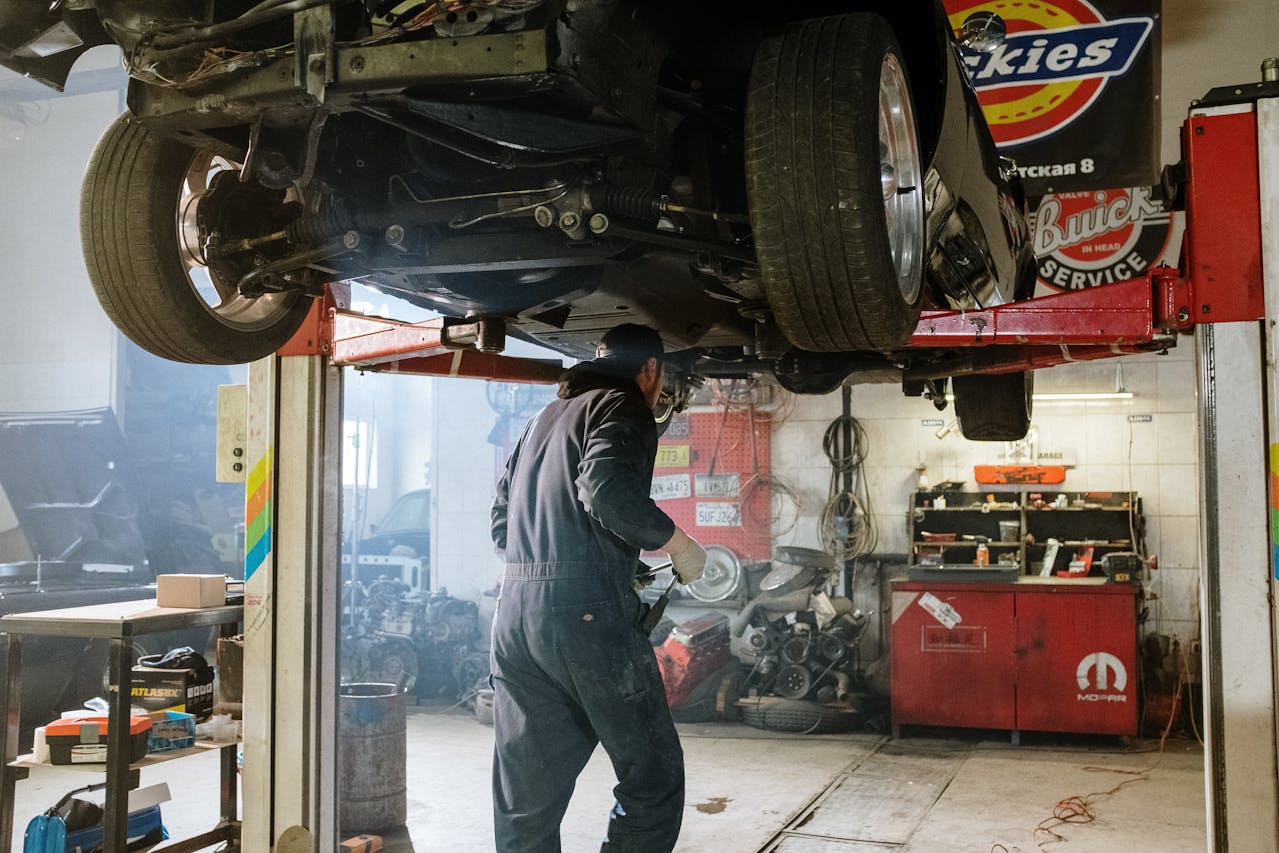Home oil changes are for the do-it-yourself car owner with a socket wrench and a little concern. DIY lets you control your oil type and save a little money. Shops, meanwhile, give you speed, safe disposal and the expertise to catch other problems early. They both work, so it’s really a matter of time, equipment and how comfortable you are with car maintenance. Others choose home oil changes for the DIY vibe and savings. Some choose shops for less mess and peace of mind. To compare the two, it helps to understand the steps and what’s required for each. The main body of this guide helps you parse what to anticipate so you can make the right selection for you.
Key Takeaways
- Assessing whether to perform an oil change at home or utilize a professional service requires careful consideration of costs, time investment, technical skill, and quality control to ensure reliable vehicle maintenance.
- By working out the costs–tools, oil, and filters–for DIY, and balancing that against possible long term savings and risks, you can figure out the best bang for your buck.
- Taking into account your level of confidence and automotive know-how — if you have none, you’re more likely to screw something up that could damage your vehicle or void your warranty.
- While performing your own oil changes, it’s imperative to follow safety guidelines, dispose of used oil responsibly and meet environmental standards.
- There are definitely benefits from taking it to a pro, including expert inspections, convenient schedules, and guaranteed workmanship — all of which can provide some peace of mind and keep your whip rolling.
- Ultimately, the decision comes down to balancing the personal gratification and educational experience of DIY with the convenience, dependability and value-added service of the pros, making the choice that best fits your lifestyle and vehicle.
The DIY vs. Shop Dilemma
The DIY vs. Shop oil change debate is a down-to-earth decision with multiple considerations. Each route has its own allure, between cost, time, skill and control over the process.
Cost Breakdown
A simple DIY oil change runs $20 to $40 — oil and filter, but no tools. Pro shops bill $50-$60. Mistakes — like buying the wrong oil or spilling — can really rack up costs, sometimes exceeding the shop prices.
Although DIY can save money in the long run, new buyers have to purchase tools such as a wrench and drain pan. If you already have these, savings accumulate with every swap. Nevertheless, a shop bundles labor and disposal, so account for those surreptitious expenses. It’s cost-effective if you’re diligent about maintaining your car and if you prefer getting your hands dirty versus the easy life.
Time Investment
It takes roughly 30 minutes to an hour to perform DIY oil changes. We’re talking about oil changes here — including setup, draining the old oil, changing the filter, and cleaning up. You may require additional time if you are a beginner at it.
A shop can complete a fast oil change in 20 minutes, though lines, appointments, or busy days may extend this. Factor in the value of your time. If you’re on a tight deadline, it may be worth paying the premium for speed.
If you’re a hands-on project person, the additional time of the DIY might feel satisfying. On the other hand, if you hate mess or cleanup, a shop is less!
Skill & Confidence
It’s easy to change oil if you know a little about cars. If you’ve never done it, it can seem dicey—wrong filter, loose plug, and you just pictured your engine on fire. If you’re uncertain, a local class or online guide can teach you the motions.
Shops employ trained staff, reducing the risk of mistakes. For starters, the peace of mind can trump any savings. Over time, DIY becomes less stressful with experience, but an initial shot can be nerve wracking.
Quality Control
DIY allows you to select the quality of oil and filters. Others favor this for peace of mind, ensuring work matches car maker’s specs. Skipping steps or the wrong parts risks engine wear.
Shops have fixed procedures, but not every tech received the same training. Fast shops might omit inspections, whereas full-service garages provide more detailed labor. DIY or shop mishaps can both injure your car, so spec double-checking counts.
Warranty coverage may depend on how oil changes are performed. Certain automakers demand evidence of professional service or authorized components. Non-brand filters or missing records may void claims. Always consult your manual before you decide to go DIY.
What a Home Oil Change Demands
A home oil change is nothing to sneeze at. It requires preparation, proper equipment, and a sharp attention to safety. Every step counts if you’re after a clean, safe, and effective oil change with no damage or injury.
Essential Tools
- Ratchet and socket to loosen the oil drain plug
- Oil catch container or drain pan, big enough to contain all the used oil
- Car jack and jack stands, or solid ramps for safely elevating the vehicle
- Funnel to avoid spills when refilling with fresh oil
- Rags or shop towels for quick clean-ups
- Gloves and safety glasses for personal protection
A car jack with jack stands is a must. Just ensure both are robust and secure enough to actually lift and support your car. Ramps can work for certain cars, but definitely verify the fit before you begin. Pay a bit extra for tools that endure—shoddy equipment invites malfunctions or, even worse, injuries. Make a checklist before you start: missing even one essential tool can bring your project to a halt.
Required Supplies
- Proper type/grade engine oil as determined by your owner’s manual
- New oil filter for your vehicle’s make and model.
- Oil absorbent pads to manage spills
- Large sealable container for old oil collection and disposal
- Replacement drain plug washer, if required for your car
- Dipstick for verifying oil level after the change
You need the proper oil and filter for your car’s engine. Anything else can damage performance and even ruin your warranty. Be sure to purchase a little more oil than you actually need, just in case of spills. Before you begin, line up your supplies for easy access—this keeps the operation flowing and avoids sloppy slow downs.
Workspace Safety
A secure workspace is a must. Be sure you’re working in a well lit, ventilated space—open a garage door or work outside if you can. Wear gloves and safety goggles no matter what. Spashing oil and dropping debris. Prior to jacking up the car, clean out clutter and look for oil drips on the floor.
Allow the engine to cool to prevent burns. If you are lifting the car, inspect jack stands or ramps are stable and secure. No speeding, a consistent pace keeps you secure.
Oil Change Basics
Allow the engine to cool. Jack the car up just enough to work underneath. PRECIOSity: Check for leaks before you begin. Drain the oil for 5 or more minutes. Change the oil filter and top off the oil, check the dipstick. Recycle your old oil!
Potential DIY Pitfalls
DIY oil changes can be satisfying, but they can be downright dangerous when performed unprepared or inexperienced. If you make a mistake, you could be looking at expensive repairs, property or bodily harm, or even environmental damage. Here’s a guide to typical slip-ups, lurking land-mines and eco obligations to remember.
- Forgetting to replace the oil filter
- Not sealing the drain plug fully or overtightening
- Overfilling or underfilling engine oil
- Using poor quality or wrong type of oil filter
- Failing to check for leaks after the job
- Working with insufficient safety equipment
- Underestimating the tools and supplies needed.
Common Mistakes
A lot of rookie DIYers forget to swap out the oil filter or use a crappy aftermarket filter without a good seal, and this causes leaks or engine damage. Another common pitfall is neglecting to fully tighten the drain plug. Over tightening can strip threads, and leaving it loose results in leaks. Not testing the oil level after topping up can cause you to overfill (damaging engine seals) or underfill (poor lubrication).
Always spread out all tools and supplies prior to beginning. For example, forget a correct oil drain pan or filter wrench and you’re going to be stuck mid-job, risking spills. Take every experience you can and learn from it what went bad. Gradually this develops ability and self-trust.
Hidden Dangers
There’s a lot of risk working under a car, and particularly with the wrong equipment. To use the little car jack, designed for tire changes, instead of a real jack and stands is dangerous. Jack stands should hold a minimum of a ton over your car’s weight. Equipment failure, such as a snapped jack or ramp, can result in serious injuries.
Hot motors, hot oil, and spills are another danger. Burns from hot surfaces, or hot oil can occur if you’re not cautious. Used oil is a known carcinogen — wear gloves and stay away from skin. Make sure you take all oil and filters to a recycling center. Careless attention to automotive fluids can cause you injury as well as environmental harm.
Environmental Duty
- Use a sealed oil drain pan to keep used oil contained.
- Take used oil and filters to a recycling facility.
- Clean up spills with absorbent material, not water.
- Never dump oil into drains, soil, or garbage.
Find out what your local regulations are on oil disposal–you don’t want to get fined. Used oil contaminates water and soil, therefore minimize waste and select green products when you can. Advocate peer safe, responsible habits.
Long-Term Maintenance Risks
Neglecting oil changes or inspections risks engine sludge, diminished performance, or even engine failure. Routine service prevents expensive fix-ups down the road.
The Professional Service Advantage
Professional oil change services offer an expertise, efficiency, and reliability that can be difficult to compete with in a DIY world. Below is a summary table that outlines the key advantages and drawbacks of each method:
|
Aspect |
Professional Service |
DIY Oil Change |
|
Expertise |
Trained technicians, thorough inspection |
Dependent on individual skill |
|
Time |
Fast, efficient, minimal disruption |
Time-consuming, requires planning |
|
Equipment |
Access to specialized tools and oils |
May lack tools or proper oil |
|
Quality Control |
Work guaranteed, industry standards met |
Risk of errors, no guarantees |
|
Disposal |
Proper used oil and filter disposal |
Must handle waste yourself |
|
Convenience |
Schedule, relax, no mess |
Need to gather supplies, cleanup |
|
Cost |
Higher upfront cost |
Lower cost, but time investment |
Expert Inspection
A professional oil change does more than trade old oil for new. Our expert mechanics look for leaks, worn belts, low fluid levels and other hidden problems that could be missed in a home garage. For high-mileage vehicles, experts know when to recommend custom oils or filters that promote engine wellness. This is especially important for cars with more than 120,000 km, where the wrong oil can speed up wear. Mechanics are trained to detect early warning signs, like gasket seepage or filter clogging, that could keep larger issues at bay. These regular inspections frequently detect small problems that might turn into big and costly repairs. For those who care to know their rides better, shop visits provide opportunities to inquire and receive immediate guidance from the boots on the ground.
Convenience Factor
Booking your oil change with Professional Service removes almost all of the hassle. No need to purchase or hoard gallons of oil, hunt down the correct filter or discard hazardous waste. Any decent shop has express bays, so it’s usually done in under an hour and back to your day with very little downtime. For busy professionals or students, the time saved can be significant. DIY oil changes take room, tools, protective gear and a cleanup commitment after the fact — scary for the uninitiated mechanic.
Guaranteed Work
One of the advantages of going to a shop is that they have a warranty. Tons of businesses offer warranties, parts and labor for a specific period of time. If they mess up–loose drain plug, wrong filter, etc.–the shop will typically fix it at no additional charge. These guarantees translate into lower risk of expensive damage from easy mistakes, something fairly common with at-home oil changes. It’s nice to know it’s done by an actual professional and to know they’re standing behind it.

The Unspoken DIY Reward
There’s more to changing your own oil than just saving a few bucks. It’s about education, empowerment, and cultivating a powerful connection with your ride. There’s a certain DIY reward in tackling this yourself, as it gives you a unique insight into what makes your vehicle tick and teaches you skills that translate elsewhere in life.
Mechanical Connection
One of the best things about getting your hands dirty during an oil change is that it helps you see what your car needs. As you open the hood, locate the drain plug and replace the oil filter–you begin to understand how the whole system functions.
This process makes you appreciate the little things. How the oil color changes, how tight to make the filter, and even the engine design. These are the actions that bring you closer to your car, not just as a driver, but as a person who loves their machine. You begin to appreciate basic maintenance and wear a badge of honor after the deed. Every time you complete an oil change, you get better. You learn by doing, and that’s the best way to get good at anything.
Deeper Knowledge
Choosing the right oil and filter for your car means understanding viscosity grades, synthetic vs. Mineral oils, and filter specs. You observe how the perfect oil transforms your car’s smoothness or mileage. If you experiment with various brands or types, you experience subtle changes in how your car sounds or feels. These lessons resonate.
This know-how helps you catch issues early. If you spot metal bits in the old oil, you’re aware that something’s amiss. Oil changes teach you a surprising amount of self-sufficiency skills that translate well to brake pad swaps, coolant flushes and even spotting leaks. You begin to make shrewd decisions on what parts or brands to purchase, how frequently to check fluids and when to perform other tasks.
Personal Satisfaction
The DIY thrill of victory Not only do you save money, but you get the know-how to believe in your own craftsmanship. You’re not merely guessing, you know you did it right. This inflates your ego.
With experience, you develop a toolbox and workflow that makes every task simpler. You begin to experience a newfound sense of empowerment and preparedness to tackle additional challenges, whether they be on wheels or in existence.
Lifelong Skill
You continue learning each time you take a job. You trust yourself more. You assist others with their vehicles. You save time and shop waits.
Making Your Final Decision
Your decision to change your oil at home or take it to a shop isn’t always so black and white. It requires time and some consideration to compare what suits you. Some folks like to enumerate all the advantages and disadvantages, while others simply follow their instinct. Cost is a huge component. DIY work is ALWAYS cheaper – you just buy the oil and filter. For example, a simple oil change-pack can be 30 to 40 euros, and a shop might ask for twice that for the same task! This excludes the cost of equipment or studio space. If you don’t have a secure place to work on your car or the proper tools, those expenses start to add up along with your stress. Shops have the equipment, and they know what they’re doing, so it’s fast and neat.
Time counts, as well. Even for skilled people, switching oil at home can take an hour or more. If you mess up, clean up is on you. A shop does it in 30 minutes, you never lift a finger. If your days are crammed, outsourcing to a shop that can provide speed and convenience is logical.
Skill is key. Oil changes seem easy, but cars are different. Others require special wrenches or attention to not damage sensors. If you have a new car with lots of tech – a shop may be safer. For older cars or if you’re handy with an engine, DIY can be a good match. If you don’t, it’s savvy to ask a friend, family or even an expert.
Consider what your car requires. Newer vehicles may require synthetic oil, or have strict warranty regulations. Shops can record, which can assist if you need to demonstrate maintenance. Consider your future plans. If you want to know your car and save dollars over years, DIY helps. If peace of mind is more important, a shop is easy and reliable.
Conclusion
Changing oil at home is great if you’re into tools and want to be intimately acquainted with your car. It conserves money and provides a feeling of accomplishment. Shops provide speed, expertise and no drips. They identify leaks and worn components quickly. Sure, home jobs cost less, but little slips cause huge fixes. Busy people or new car people probably want the convenience of a shop. If you trust your abilities, go the home route. If not, save yourself the hassle and choose a shop. Both roads keep your ride smooth. Your selection should suit your needs and style. For more tips or to share your story, scribble a note or check out the blog.
Frequently Asked Questions
1. Can I change my oil at home safely?
So, can I change my oil at home or go to a shop? As always, adhere to your vehicle’s manual and use quality oils/filters.
2. What tools do I need for a home oil change?
Oil filter wrench, drain pan, socket set, funnel, gloves. Check that you have the right type and quantity of oil and a new oil filter.
3. Is changing oil at home cheaper than going to a shop?
Changing oil at home can often be cheaper because you only pay for parts. A shop gives you know-how, the disposal of old oil and occasionally a warranty.
4. What are the risks of changing my own oil?
Risks such as spills, the wrong oil, over or under tightening parts, and incorrect disposal of used oil. These errors can wreck your engine or the environment.
5. How often should I change my oil?
Consult your manual, but most cars require a change every 5,000 – 10,000 kilometers. Depending on driving conditions and oil, this interval may vary.
6. Why do people choose professional oil changes?
Pros – convenience, expertise and fast. They safely dispose of used oil and might catch other maintenance issues while they’re servicing your car.
7. What is the benefit of doing my own oil change?
There’s nothing quite like changing your oil at home — it saves money and gives you that handyman glow. It allows you to educate yourself on your vehicle’s maintenance requirements.
Time for an Oil Change? Let’s Make It Count.
Don’t let something as simple as old oil turn into a big repair bill. At autoTECH Blackhawk, we don’t just do oil changes — we protect your engine, extend the life of your vehicle, and treat you like family every mile of the way.
Whether your dashboard reminder is flashing or you’re just not sure when your last oil change was, we’ve got you. Our expert techs use only manufacturer-recommended oil and filters, and every service is backed by our industry-leading 3-year/36,000-mile warranty.
Need conventional or synthetic? We’ll help you choose what’s best for your car — and your driving style.
Fast. Friendly. Reliable.
Schedule your contactless oil change today and see why drivers across the Bay Area trust autoTECH Blackhawk to keep their engines running strong.
Book now at AutoTECH Blackhawk or give us a call — let’s keep you moving, worry-free.


